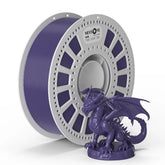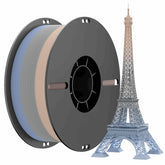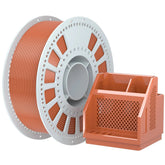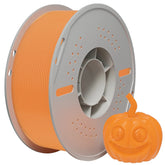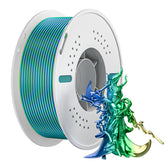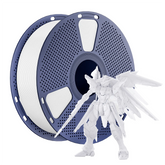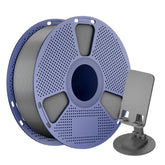FDM 3D Printing Filament Guide: PLA, PETG, and ABS for Beginners

Embarking on your 3D printing journey can be both exciting and overwhelming, especially when choosing the right filament. Among the myriad of options, PLA, PETG, and ABS stand out as the most popular choices for Fused Deposition Modeling (FDM) printers. This guide aims to demystify these materials, helping you make an informed decision for your projects.
1. PLA (Polylactic Acid) – The Beginner’s Choice
Pros:
✅ Easy to print – Low warping, no heated bed required.
✅ Eco-friendly – Made from biodegradable materials like cornstarch.
✅ Wide variety – Available in colors, glitter, wood-filled, and even glow-in-the-dark.
✅ Low odor – Safe for home use.
Cons:
❌ Low heat resistance – Deforms at ~60°C (not suitable for hot environments).
❌ Brittle – Not ideal for mechanical stress.
Best For:
- Prototyping
- Decorative prints
- Educational projects
2. PETG (Polyethylene Terephthalate Glycol) – The All-Rounder
Pros:
✅ Strong & flexible – More durable than PLA, less brittle.
✅ Heat resistant – Handles temperatures up to ~80°C.
✅ Chemical & water-resistant – Great for functional parts.
✅ Good layer adhesion – Minimal warping.
Cons:
❌ Stringing issues – Requires fine-tuned retraction settings.
❌ Sticks too well – May damage build surfaces if not careful.
Best For:
- Functional parts (gears, tools)
- Outdoor applications
- Food-safe containers (if FDA-approved)
3. ABS (Acrylonitrile Butadiene Styrene) – The Tough Classic
Pros:
✅ High strength & durability – Used in LEGO bricks and car parts.
✅ Heat resistant – Withstands temperatures up to ~100°C.
✅ Can be smoothed – Acetone vapor polishing for a glossy finish.
Cons:
❌ Difficult to print – Requires a heated bed (~100°C) and enclosed chamber to prevent warping.
❌ Strong fumes – Needs good ventilation (not ideal for small spaces).
Best For:
- Automotive parts
- High-stress mechanical components
- Industrial prototypes
📊 Quick Comparison Table
| Property | PLA | PETG | ABS |
|---|---|---|---|
| Ease of Use | ⭐⭐⭐⭐⭐ | ⭐⭐⭐⭐ | ⭐⭐ |
| Strength | ⭐⭐ | ⭐⭐⭐⭐ | ⭐⭐⭐⭐⭐ |
| Flexibility | ⭐ | ⭐⭐⭐ | ⭐⭐ |
| Heat Resistance | ⭐ | ⭐⭐⭐ | ⭐⭐⭐⭐⭐ |
| Print Temp (°C) | 180–220 | 220–250 | 230–260 |
| Heated Bed | Not Required | Recommended | Required |
| Post-Processing | Easy | Moderate | Challenging |
Which Filament Should You Choose?
- For beginners: Start with PLA – it’s forgiving and widely available.
- For functional parts: PETG offers a great balance of strength and ease of use.
- For high-temp or industrial use: ABS is ideal but requires a controlled environment and experience.


